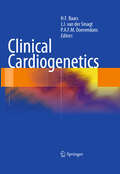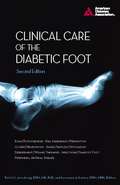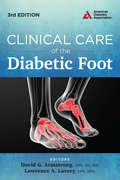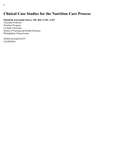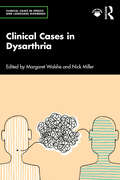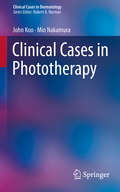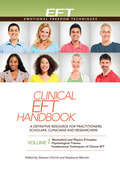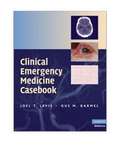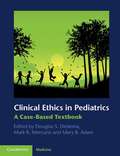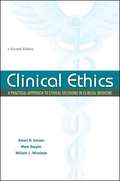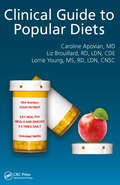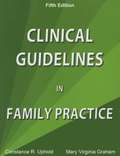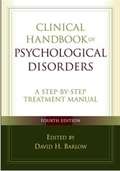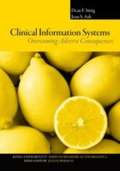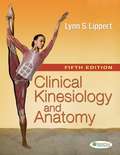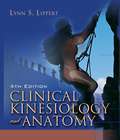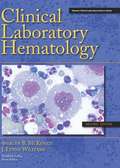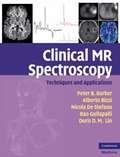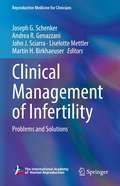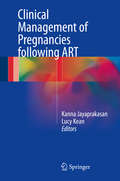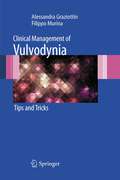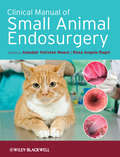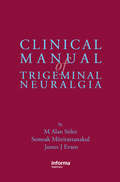- Table View
- List View
Clinical Cardiogenetics
by H. F. Baars J. J. van der Smagt P. DoevendansClinical management and signs are the focus of this practical cardiogenetic reference for those who are involved in the care for cardiac patients with a genetic disease. With detailed discussion of the basic science of cardiogenetics in order to assist in the clinical understanding of the topic. The genetic causes of various cardiovascular diseases are explained in a concise clinical way that reinforces the current management doctrine in a practical manner. The authors will cover the principles of molecular genetics in general but also specific to cardiac diseases. They will discuss the etiology, pathogenesis, pathophysiology, clinical presentation, clinical diagnosis, molecular diagnosis and treatment of each cardiogenetic disease separately. Therapy advice, ICD indications, indications for and manner of further family investigation will all be covered, while each chapter will also contain take-home messages to reinforce the key points. The chapters reviewing the different diseases will each contain a table describing the genes involved in each. Each chapter will also contain specific illustrations, cumulatively giving a complete, practical review of each cardiogenetic disease separately. Special emphasis will be given to advice on how to diagnose and manage cardiogenetic diseases in clinical practice, which genes should be investigated and why, and the pros and cons of genetic testing. Guidelines for investigation in families with sudden cardiac death at young age will also be included. This book will be written for the general cardiologist and the clinical geneticist who is involved in cardiac patients and will provide answers to question such as: Which genes are involved and which mutations? What is the effect of the mutation at cellular level? Which genes should be tested and why? What is the value of a molecular diagnosis? Does it influence therapy? When should the first degree relatives be tested and in which way?
Clinical Care of the Diabetic Foot
by David G. Armstrong Lawrence A. LaveryThe diabetic foot is a victim of nerve damage, micro- and macrovascular disease, and faulty healing, mechanisms that without proper care can lead to amputation. More than 80,000 diabetes-related amputations are performed in the United States each year, but non-specialist primary care providers, as well as residents, nurses, and diabetes educators, can help prevent this devastating, life-altering, and expensive complication. Health care professionals and students alike will find that this concise, easy-to-use, and updated guide offers practical advice on detecting and managing diabetes-related foot complications, including information on:Patient risk factors and preventive footwearConducting comprehensive foot examsWound care: debridement and offloadingManaging infections and faulty healingCharcot foot and peripheral arterial diseaseWritten and revised by renowned experts in the field, Clinical Care of the Diabetic Foot, 2nd edition, illuminates an often overlooked but vitally important area of diabetes management and suggests strategies to help clinicians provide state-of-the-art foot care for their patients with diabetes.
Clinical Care of the Diabetic Foot 3rd Edition
by David G. Armstrong MPH Lawrence A. Lavery DpmThe third edition of Clinical Care of the Diabetic Foot has been fully revised and updated, and continues to be the essential handbook on foot care and the treatment of the diabetic foot. <P><P> The diabetic foot is typically the victim of nerve damage, micro- and macrovascular disease, and faulty healing, mechanisms that without proper care can lead to amputation. More than 80,000 diabetes-related amputations are performed in the United States each year, but non-specialist primary care providers, as well as residents, nurses, and diabetes educators, can help prevent this devastating, life-altering, and expensive complication. Healthcare professionals and medical students alike will find that this concise, well-indexed, and updated guide offers practical advice on detecting and managing diabetes-related foot complications.
Clinical Case Studies for the Nutrition Care Process
by Elizabeth Zorzanello EmeryDesigned for graduate nutrition students, dietetic interns, and practicing dietitians, Clinical Case Studies for the Nutrition Care Process presents realistic scenarios for a variety of cases organized in the format of the Nutrition Care Process. Cases are drawn from the author’s experience and collected from practitioners who are experts in their field, providing a variety of interesting scenarios. Topics such as adolescent obesity and dietary management in diabetes are explored. <p><p> As a part of the American Dietetic Association’s Nutrition Care Process (NCP), dietitians, educators, and students have been asked to adopt a new standardized language for nutrition diagnosis. While this process utilizes many aspects of the traditional care model, dietitians may be unsure of how to implement the completely new aspect of standardized language and Nutrition Diagnosis. <p><p> Not only does this book include an introductory section on the Nutrition Care Process, but readers will learn how to use the standardized terms, develop a nutrition diagnosis, and apply the standardized language to specific clinical cases.
Clinical Cases in Dysarthria (Clinical Cases in Speech and Language Disorders)
by Nick Miller Margaret WalsheThrough the medium of detailed clinical case reports, written by well-respected clinicians and researchers working internationally in the field, Clinical Cases in Dysarthria discusses the challenges, and rewards of applying evidence-based procedures to people with dysarthria in real-life busy routine clinical settings. The text opens with an introduction to the latest research and practices within dysarthria treatment and sets the scene for the eight individual case reports which follow. These case reports form the core chapters of the text and cover themes that range from clinical diagnostic conundrums to applying popular, and/or novel intervention approaches to different populations where dysarthria presents. Each chapter has a specific argument drawing on theoretical principles of assessment and rehabilitation, incorporating latest research evidence to help readers problem-solve similar cases in their clinical practice. Throughout the text, readers are encouraged to ‘think outside the box’. This book will be essential for undergraduate and postgraduate student clinicians within speech and language therapy/pathology courses, as well as clinicians new to the field of dysarthria.
Clinical Cases in Phototherapy (Clinical Cases in Dermatology)
by John Koo Mio NakamuraThis case book will be based on real life scenarios of patient cases which have been encountered over several decades in one of the largest phototherapy centers in the United States. To our knowledge, there has not been anything similar published to date. By presenting various cases and how to manage such cases, we aim to educate dermatology trainees and practicing dermatologist who are trying to familiarize themselves with phototherapy. A recent study has shown that many dermatologists do not know how to administer phototherapy, and most graduating residents do not have adequate teaching and experience with administering phototherapy during their residencies. Therefore, the hope is that this book will fill a critical gap in the field of dermatology.
Clinical EFT Handbook Volume 1: A Definitive Resource For Practitioners, Scholars, Clinicians And Researchers (Clinical Eft Handbook Ser.)
by Stephanie Marohn Dawson ChurchEFT (Emotional Freedom Techniques or "tapping") is used by an estimated 10 million people worldwide. Yet a lack of standardization has led to a field in which dozens of forms of EFT, with varying degrees of fidelity to the original, can be found. This led to the establishment of Clinical EFT, the form of EFT taught in the original EFT Manual and associated materials, and validated in over 20 clinical trials. In this volume, the most noted scholars, researchers and clinicians in the field compile a definitive outline of the EFT protocol, as it is applied in medicine, psychiatry, psychotherapy, and life coaching. This first volume covers • Biomedical and Physics Principles • Psychological Trauma • Fundamental Techniques of Clinical EFT. This series of handbooks is essential reading for anyone wishing to understand EFT as validated in research, science, and best clinical practice.
Clinical Emergency Medicine Casebook
by Joel T. Levis Gus M. GarmelEmergency Medicine is not divided into specific areas of practice. Emergency room visitors come in all shapes and sizes, at any time of day or night, with a wide range of maladies. Emergency physicians need to become experts in diverse areas of medicine and to be able to make quick and informed decisions about patient care. A cornerstone of emergency medicine training is the constant drilling and re-drilling of simulated cases and clinical scenarios. This book offers a unique yet underutilized strategy for learning: a case-based approach from real patients and actual events. Each case provides the opportunity for learning essential clinical concepts. Focused exclusively on the needs of in-training emergency physicians and nurses, the book covers more than 100 common and unusual cases in emergency medicine. The procedures have been class-tested by the Stanford/Kaiser Emergency Medicine Residency Program.
Clinical Emergency Radiology
by J. Christian FoxThis book is a new clinical resource in the field of emergency radiology and comprehensively covers both the technical applications and interpretation of all imaging studies utilized in the emergency room, including x-rays, MRI, CT, and contrast angiography. The full spectrum of conditions diagnosed within each modality is covered in detail, and examples of normal radiologic anatomy, patterns, and anomalies are also included. Clinical Emergency Radiology is designed to be a standard reference for emergency physicians and contains over 2,000 images to comprehensively cover every aspect of radiology in the emergency room.
Clinical Ethics in Pediatrics: A Case-based Textbook
by Douglas S. Diekema Mark R. Mercurio Mary B. AdamThis volume provides a practical overview of the ethical issues arising in pediatric practice. The case-based approach grounds the bioethical concepts in real-life situations, covering a broad range of important and controversial topics, including informed consent, confidentiality, truthfulness and fidelity, ethical issues relating to perinatology and neonatology, end-of-life issues, new technologies, and problems of justice and public health in pediatrics. A dedicated section also addresses the topics of professionalism, including boundary issues, conflicts of interests and relationships with industry, ethical issues arising during training, and dealing with the impaired or unethical colleague. Each chapter contains a summary of the key issues covered and recommendations for approaching similar situations in other contexts. Clinical Ethics in Pediatrics: A Case-Based Textbook is an essential resource for all physicians who care for children, as well as medical educators, residents and scholars in clinical bioethics.
Clinical Ethics: A Practical Approach to Ethical Decisions in Clinical Medicine (Seventh Edition)
by Albert R. Jonsen William J. Winslade Mark SieglerThis book is about the ethical issues that clinicians encounter in caring for patients such as informed consent, truth telling, confidentiality, privacy, the distinction between research and clinical care, and end-of-life care.
Clinical Guide to Popular Diets
by Caroline Apovian Lorraine Young Elizabeth BrouillardIt is no secret that the United States is facing an obesity epidemic with the obesity rates continuing to rise year after year. According to the Center for Disease Control, one third of Americans are now obese. It is no longer sufficient to simply point out the health risks of obesity to our patients as the reason to lose weight. Patients are seeking guidance in terms of what specific diet plan to follow and what foods should be eaten. There are thousands of diets on the market with new ones introduced daily. Not all diet plans have proven results, nor will they work for every patient. More importantly, not all diets marketed to the public are safe to follow for an extended timeframe. In fact, research shows us that diet composition is not the key to long term success, but compliance to a calorie deficient diet is the solution. So how does one choose which diet plan to recommend to patients? Finally, a book for clinicians is here to help answer this question. This book provides information to help patients understand several different research proven diets on the market today including: the Atkins diet, the DASH (Dietary Approaches to Stop Hypertension) diet, the I diet, the Mediterranean diet, Paleo Diets, South Beach, Vegetarian diets, Weight Watchers, and the Zone diet. Each diet is carefully and thoroughly reviewed in this book by some of America’s top obesity medicine and weight management specialists to provide health practitioners a knowledge of the diet composition, current research evaluating the diet, typical weight loss results, the pros and cons of the diet as well as which patients would most benefit from each diet plan. This book provides the necessary tools for clinicians to feel comfortable discussing several of the more popular and scientifically researched diets with patients. This book offers solid information to advise patients, based on their specific health history, on which diet will afford the greatest chance for success.
Clinical Guidelines In Family Practice (Fifth Edition)
by Constance R. Uphold Mary Virginia GrahamClinical Guidelines in Family Practice, 5th edition, is the fully revised and updated version of a book that has been serving primary care clinicians for more than twenty years. Using a traditional and easy-to-follow format, the book examines all of the common conditions encountered in primary care settings, while also addressing health promotion and disease prevention. For each topic, the essentials of pathophysiology, clinical presentation, diagnosis, and corresponding treatment plans including prognosis and recommended follow-up schedules are sequentially organized. Also included are recommended web-based resources and references to more in-depth discussion of the various topics. As in previous editions, Clinical Guidelines in Family Practice aims for thoroughness in coverage and for concision in approach, a formula that helps clinicians to efficiently recognize and treat the myriad medical conditions that they face as primary-care providers.
Clinical Handbook of Psychological Disorders: A Step-by-Step Treatment Manual (4th edition)
by David H. BarlowThis clinical guide and widely adopted text provides students and practitioners with state-of-the-science guidelines for treating frequently encountered adult disorders. Contributors are leading clinical researchers who present essential background knowledge on each problem, describe the conceptual and empirical bases of their respective approaches, and detail the nuts and bolts of evidence-based assessment and intervention.
Clinical Handbook of Psychological Disorders: A Step-by-Step Treatment Manual (Third Edition)
by David H. BarlowWritten primarily from a cognitive-behavioral perspective, this book describes treatment methods for various disorders.
Clinical Information Systems: Overcoming Adverse Consequences
by Dean F. Sittig Joan S. AshAs the number of healthcare organizations beginning to implement clinical information systems grows, the number of unanticipated and unintentional consequences inevitably increases as well. While existing research suggests that much good can come from clinicians entering orders directly, errors or other unintended consequences related to technology may arise. Ideal for both clinicians and information technology professionals, Clinical Information Systems: Overcoming Adverse Consequences helps fledgling organizations better prepare for the inevitable challenges and obstacles they will face upon the implementation of such systems. Based on the research and findings from the Provider Order Entry Team from the Oregon Health & Science University, this book discusses the nine categories of unintended adverse consequences that occurred at many of the leading medical centers during their implementation and maintenance of a state-of-the-art clinical information system. It goes on to present the best practices they identified to help organizations overcome these obstacles.
Clinical Kinesiology and Anatomy (Fifth Edition)
by Lynn S. LippertThis book provides fundamental understanding of Kinesiology and anatomy from a clinical perspective.The anatomical basis of common pathological conditions is briefly described in most chapters to give greater clinical relevance.
Clinical Kinesiology and Anatomy (4th edition)
by Lynn S. LippertLynn Lippert adds a greater emphasis on clinical insights and functional connections to her easy-to-understand, well-organized 4th edition text. This accurate and thoughtfully updated edition is what should be at the heart of the clinical kinesiology course to help students analyze the mobility of specific joints in various activities of daily living. The first seven chapters describe the various body systems, terminology, and biomechanical principles that will be applied in the individual joint chapters that follow.
Clinical Laboratory Hematology (Second Edition)
by Shirlyn B. MckenzieDesigned to meet the needs of both clinical laboratory technicians and clinical laboratory scientists, CLINICAL LABORATORY HEMATOLOGY has been updated into a brand new edition. This comprehensive--yet easy to read--guide to hematology and hemostasis features cutting-edge technologies, high-quality photographs and micrographs, case studies, and convenient dual-level (basic and advanced) presentation of information. Visual cross-referencing (symbols) throughout make finding information exceptionally easy. Key chapters are presented by a number of different authors and experts in the field and include information on: cellular homeostasis; the Stucture and Function of Hematopoietic Organs; Hemolytic anemia; Nonmalignant lymphocyte disorders and much more.
Clinical MR Spectroscopy
by Peter B. Barker Alberto Bizzi Nicola De Stefano Rao P. Gullapalli Doris D. M. LinIn vivo magnetic resonance spectrosopy (MRS) is increasingly being used in clinical practice, particularly for neurological disorders.
Clinical Management of Infertility: Problems and Solutions (Reproductive Medicine for Clinicians #2)
by Andrea R. Genazzani Liselotte Mettler Joseph G. Schenker John J. Sciarra Martin H. BirkhaeuserThis new volume in the Reproductive Medicine for Clinicians series focuses on the practical clinical impact of problems linked to infertility, discussing topics such as luteal support in ART cycles, ovulation induction using pulsatile administration of GnRH, how to deal with the metabolic changes in PCOS, treatment to restore fertility in endometriosis and how to improve implantation, which are common aspects of daily clinical practice.It also addresses significant novel areas like the biological clock in human reproduction, reproduction at advanced parental age and medical and social egg freezing, offering valuable insights for patients and their doctors. Further, the book covers various areas of growing importance, such as how to access the uterine cavity; the future of imaging in reproduction; non-invasive prenatal testing; ART and male infertility; as well as breast cancer and fertility preservation.Last but not least, it examines the medical, ethical and legal aspects of a number of challenges for current and future reproductive medicine, including uterine transplantation and human genetic modification.Bringing together updates on some of the most important problems in reproductive medicine and also covering ethical and legal bases, this book offers an overview of potential treatments for infertility. As such, it is a valuable resource for gynecologists, obstetricians, endocrinologists and all specialists dealing with reproductive health.
Clinical Management of Pregnancies following ART
by Kanna Jayaprakasan Lucy KeanThis book provides a detailed overview of the possible risks associated with ART pregnancies and their clinical management. While most pregnancies following Assisted Reproduction Treatment (ART) will progress normally and without any complications to mother or baby, some women who conceive after ART as well as their babies are at increased risk of pregnancy complications. There are some schools of thoughts proposing pregnancies following IVF should be regarded as being "high risk" and requires special attention. There are various reasons why ART pregnancies may be at higher risk - Female and male age factor, increased chance of multiple pregnancies, underlying cause of subfertility (pelvic pathology, uterine pathology, endometrial dysfunction) and potential increase in birth defects. This is an essential read for obstetricians, fertility specialists and Post-graduate trainees.
Clinical Management of Vulvodynia: Tips and Tricks
by Filippo Murina Alessandra GraziottinChronic vulvar pain, or 'vulvodynia', is a common problem that can have a considerable impact on the wellbeing of patients. Despite being seen routinely in everyday clinical practice, it remains a neglected disorder that may take many years to diagnose. This book eases the way for physicians, including General Practitioners and Gynecologists, who are motivated to improve the lives of women suffering from vulvodynia. By offering a concise overview of the latest information on the diagnosis and management of vulvodynia, and its numerous comorbidities, in an easy to read, 'tips and tricks' format, the book empowers physicians to rapidly and effectively address the complex and sensitive issues surrounding the disorder.
Clinical Manual of Small Animal Endosurgery
by Alasdair Hotston Moore Rosa Angela RagniA practical and comprehensive guide to rigid endoscopy and endosurgery in small animal practice. Fully illustrated throughout, it covers the clinical treatment of small animals from pre-operative through to post-operative care. With reference to specific procedures, this manual includes guidance on the selection of equipment, surgical techniques, anaesthesia and possible complications. A specialist chapter advising on the treatment of birds, reptiles and small mammals is also included.Clinical Manual of Small Animal Endosurgery will enable veterinarians to develop and improve their endoscopic techniques in clinical practice, as well as providing guidance on referral options for more complex cases.KEY FEATURES* Provides comprehensive information on how to perform rigid endoscopic investigations and procedures.* The focus is on dogs and cats with a specialist chapter covering the treatment of exotic small animals* Contains many full colour clinical photographs* Written and edited by experts in the field
Clinical Manual of Trigeminal Neuralgia
by James Evans M. Alan Stiles Somsak MitrirattanakulResearch into pain has grown exponentially over the past few years, and our understanding of mechanism and pharmacology has also developed. Trigeminal neuralgia often goes unrecognized or is mistaken for other causes of facial pain, and while the cause often cannot be determined, it can be associated with multiple sclerosis, herpes zoster, and vari
